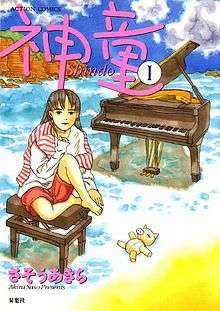Shindō (manga)
| Shindō | |
 First volume of Shindō written and illustrated by Akira Sasō, published by Futabasha | |
| 神童 | |
|---|---|
| Manga | |
| Written by | Akira Sasō |
| Published by | Futabasha |
| Demographic | Seinen |
| Magazine | Weekly Manga Action |
| Original run | April 16, 1997 – June 9, 1998 |
| Volumes | 4 |
| Novel | |
| Written by | Koji Hagiuda |
| Published by | Futabasha |
| Demographic | Mature |
| Published | March 15, 2007 |
| Live-action film | |
| Directed by | Koji Hagiuda |
| Written by | Kousuke Mukai |
| Released | April 27, 2007 |
| Runtime | 120 minutes |
Shindō (Japanese: 神童, Prodigy) is a Japanese manga written and illustrated by Akira Sasō. The story depicts a 13-year-old piano child prodigy, Uta Naruse, who helps 19-year-old Wao Kikuna, enter a conservatory to study the piano.
Media
The manga was serialized in Futabasha's seinen manga magazine, Weekly Manga Action. The individual chapters were collected into four bound volumes, which Futabasha released from May 28, 1998 to August 28, 1998.[1][2] Futabasha re-released the manga into three volumes, which were all released on December 19, 2003.[3]
The manga was adapted into a novel by Koji Hagiuda, which Futabasha released on March 15, 2007.[4] Epic/Sony Records released a soundtrack CD on March 21, 2007.[5]
The novel was further adapted into a live action film, with Koji Hagiuda directing his own novel and screenplay written by Kousuke Mukai, which premiered in Japan on April 27, 2007.[6] Riko Narumi was cast as Uta and Kenichi Matsuyama was cast as Wao.[6] The theme music was performed by Mito of Clammbon.[6] VAP released the film's DVD on November 21, 2007.[7][8]
Reception
The manga received the excellence award in the manga division for the 2nd Japan Media Arts Festival and the award for excellence for the 3rd Tezuka Osamu Cultural Prize in 1999.[9][10][11]
The Japan Times' Mark Schilling commends Riko Narumi's performance as Uta, "which is forceful, but somehow mysterious, like the fierce-eyed girls painted by Yoshitomo Nara."[6] Chris Magee commends the film as "a truly touching and surprisingly grown up look at just how difficult it can be for people, young or old, to come to terms with their talents and strengths, but also their faults and their weaknesses."[12]
References
- ↑ 神童 1 [Shindo 1] (in Japanese). Futabasha. Archived from the original on January 3, 2014. Retrieved January 3, 2014.
- ↑ 神童 4 [Shindo 4] (in Japanese). Futabasha. Archived from the original on January 3, 2014. Retrieved January 3, 2014.
- ↑ コミック文庫)神童 1 [Shindo 1 (Manga)] (in Japanese). Futabasha. Archived from the original on January 3, 2014. Retrieved January 3, 2014.
コミック文庫)神童 2 [Shindo 2 (Manga)] (in Japanese). Futabasha. Archived from the original on January 3, 2014. Retrieved January 3, 2014.
コミック文庫)神童 3 [Shindo 3 (Manga)] (in Japanese). Futabasha. Archived from the original on January 3, 2014. Retrieved January 3, 2014. - ↑ 小説 神童 [Novel: Shindo] (in Japanese). Futabasha. Archived from the original on January 3, 2014. Retrieved January 3, 2014.
- ↑ 「神童」オリジナル・サウンドトラック [Shindo Original Soundtrack] (in Japanese). Oricon. Archived from the original on January 3, 2014. Retrieved January 3, 2014.
- 1 2 3 4 Schilling, Mark (April 27, 2007). "Shindo". The Japan Times. Archived from the original on April 13, 2012. Retrieved January 3, 2014.
- ↑ 神童(通常版) [Shindo (Limited Edition)] (in Japanese). Oricon. Archived from the original on January 3, 2014. Retrieved January 3, 2014.
- ↑ 神童(2枚組スペシャル・エディション)(初回生産限定) [Shindo (2-Disc Special Edition) (First Press Limited)] (in Japanese). Oricon. Archived from the original on January 3, 2014. Retrieved January 3, 2014.
- ↑ "The Road to Glory: Manga Awards - Tezuka Cultural Award". Comipress. July 13, 2007. Archived from the original on June 4, 2012. Retrieved January 3, 2014.
- ↑ "1998[2nd]Japan Media Arts Festival". Japan Media Arts Festival. Archived from the original on October 13, 2007. Retrieved January 3, 2014.
- ↑ Chījō, Shōhei (2003). 読んでから死ね! 現代必読マンガ101 [101 Must-read Modern Manga] (in Japanese). Bungeishunjū. p. 90. ISBN 978-4163650203.
- ↑ Magee, Chris (December 12, 2008). "Review: Shindō (Prodigy)". Toronto J-Film Pow-Wow. Archived from the original on January 3, 2014. Retrieved January 3, 2014.
External links
- Shindō at the Internet Movie Database
- Adventures of Modern Comics: From Katsuhiro Ohtomo to Natsume Ono (Japanese) (pg. 299-305)